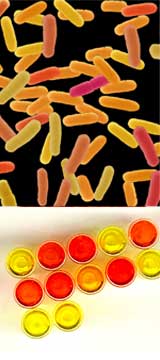'Directed Evolution' Creates Unusual Carotenoid- Producing Bacteria

As reported in the July issue of Nature Biotechnology by Caltech chemical engineer Frances H. Arnold and University of Minnesota biochemist Claudia Schmidt-Dannert, the researchers first shuffled E. coli genes and genes from other bacteria which normally make carotenoids. After screening the resulting library for gene products, they were able to identify strains of E. Coli capable of making novel carotenoids. One such product was the fully conjugated carotenoid, 3,4,3',4'-tetradehydrolycopene.

Artist's rendering of colored bacteria made by molecular biology (top). Extracts from bacterial cells that produce new carotenoids (bottom). (Source: California Institute of Technology.)
The investigators next embarked on a second round of gene shuffling between their hybrid E. coli strains and other carotene-producing bacteria. After screening the resulting libraries of products, they isolated a modified E. coli strain capable of making the red-colored cyclic carotenoid torulene, something never before known to be produced by E. coli.
According to Schmidt-Dannert, these results mean that "we are now able to create natural products that usually have to come at great cost from esoteric sources simply by breeding ordinary genes in ordinary laboratory organisms." She and her colleagues predict that their method will be widely useful for making complex and expensive natural molecules such as antibiotics, dyes, and flavors. And, according to the authors, an even more inviting target of directed evolution is finding bacteria that make biological molecules not yet found in nature.
For more information, contact Frances H. Arnold, Caltech, Div. of Chemistry and Chemical Engineering, at frances@cheme.caltech.edu; Claudia Schmidt-Dannert, University of Minnesota, Dept. of Biochemistry, Molecular Biology and Biophysics, at schmi232@tc.umn.edu.
By Gordon Graff
